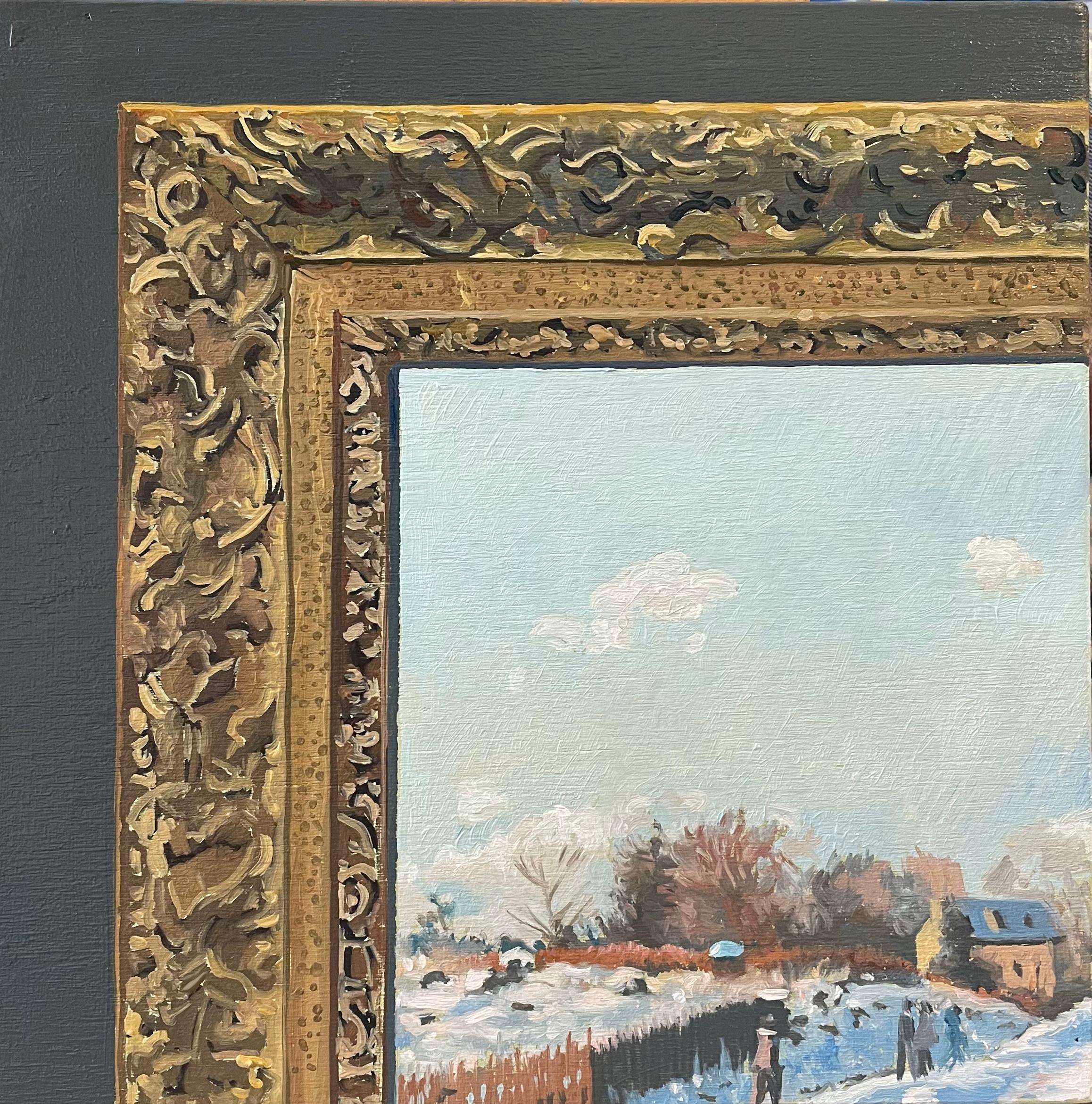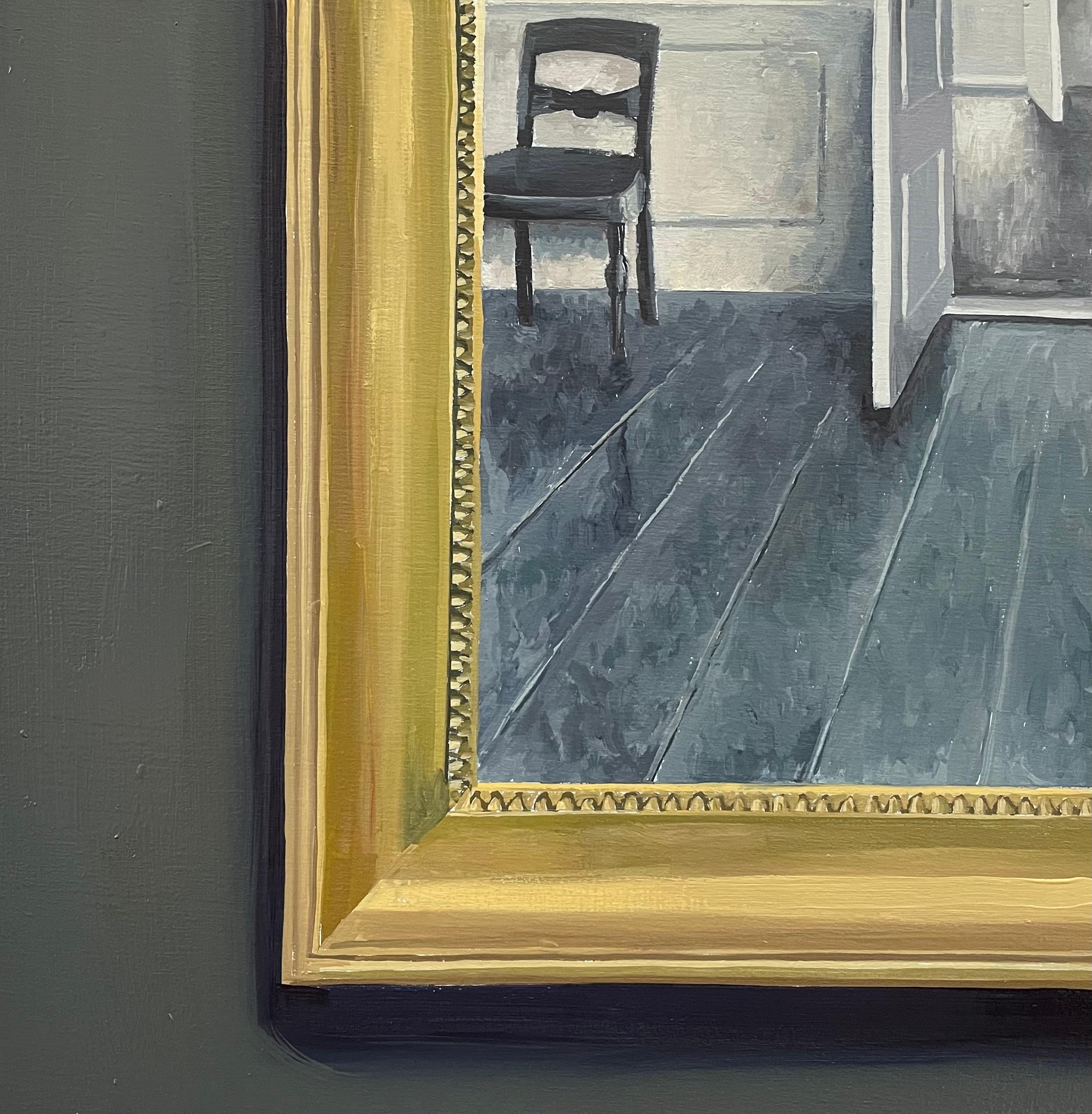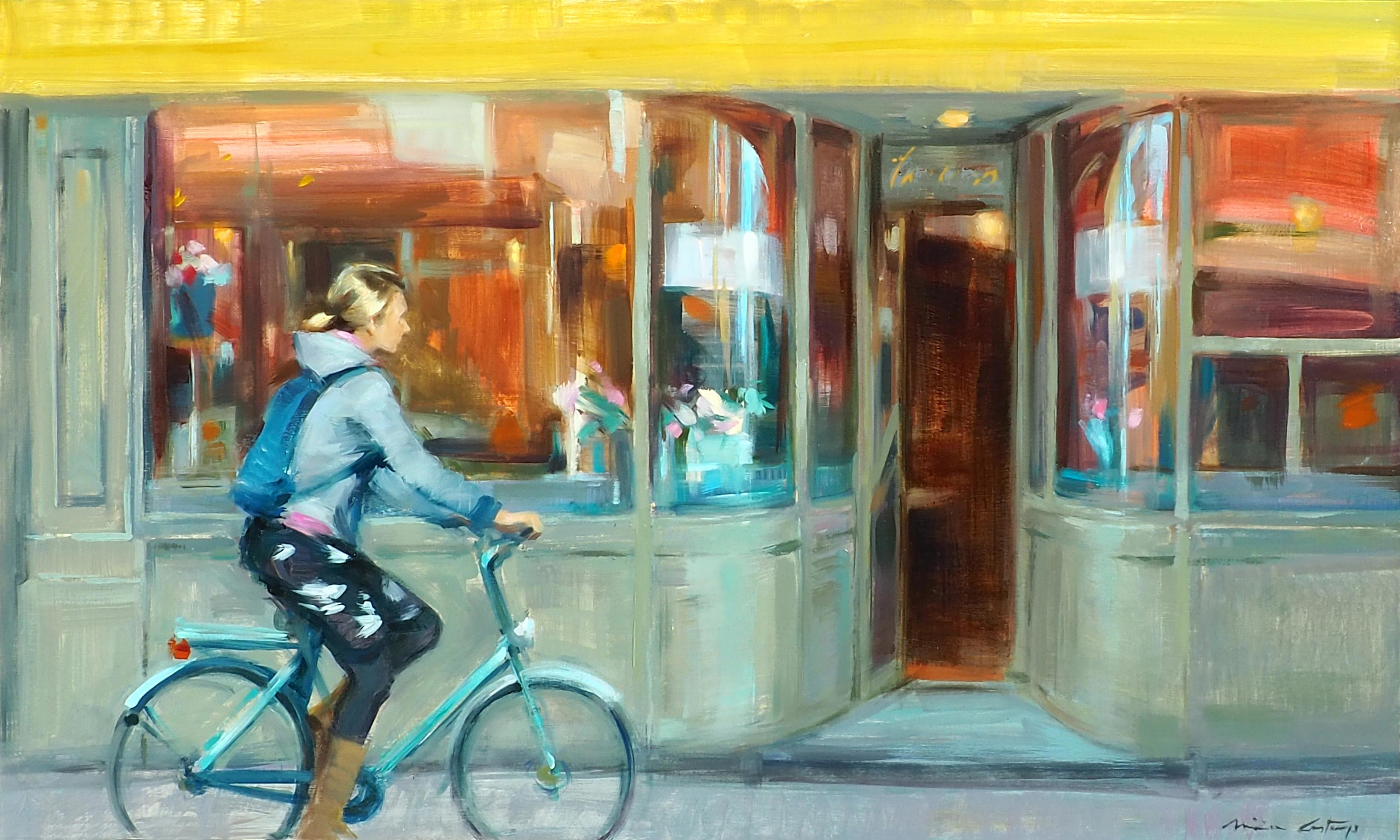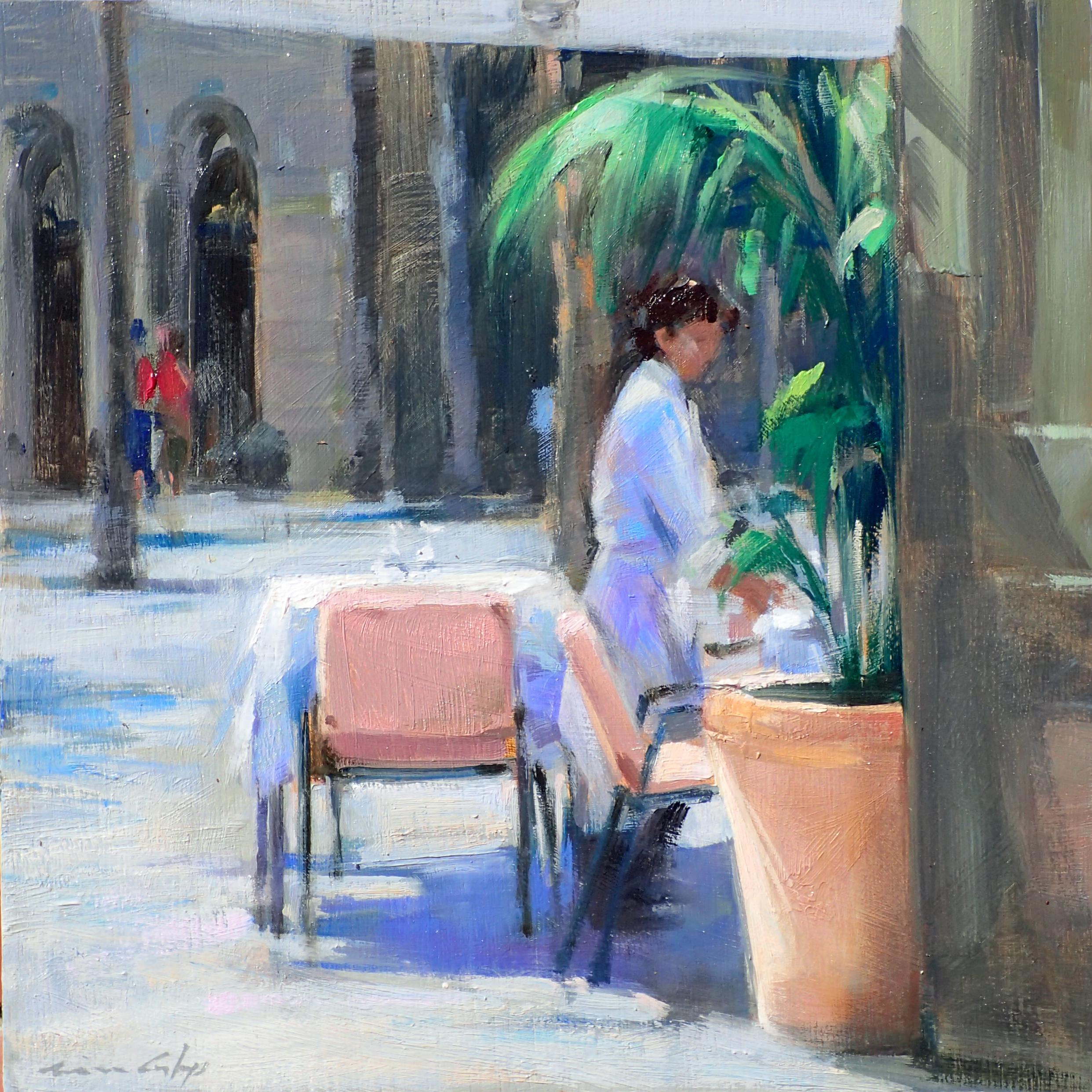Items Similar to John F. Kennedy International Airport
Want more images or videos?
Request additional images or videos from the seller
1 of 8
Marc TrujilloJohn F. Kennedy International Airport2015
2015
About the Item
Every detail in Trujillo’s fast-paced, consumer-driven environments is the result of slow painting, of careful and keen observation, both analytic and synthetic. Trujillo depicts his contemporary urban surroundings with such detail and lucidity that one feels instantly transported—somewhere, nowhere, to a place we all know, or think we know. Although he uses photographs for reference, Trujillo’s paintings are not photorealistic. His three-dimensional space and myriad light sources cannot be found in a single camera shot or in the neutral, objective realism of a photograph. Instead, his paintings are based on direct observation, color sketches, and rigorous drawing, as well as dedication to the panoramic landscapes and interiors of seventeenth-century Dutch Masters. Trujillo cites artists such as Vermeer, Velazquez, and Rembrandt as inspiration for his craft of painting, and the importance of control over formal elements. For Trujillo, light is what holds his paintings together as he creates shifting temperatures throughout the compositions where mood and atmosphere are carefully orchestrated. Like frames from a motion picture, Trujillo’s scenes and the characters in them are ultimately invented and placed with purpose. Painting from what he calls “the middle ground of common experience,” Trujillo uses his environments as the foundation for a personal vision. Ever mindful that his paintings are neither “critique nor worship,” he distances himself from human dramas and avoids overt irony and fantasy. In spite of this, Trujillo’s scenes force us to look closely at the world around us, revealing truths that evoke discomfort or elicit thought and self-examination. Ultimately, Trujillo’s paintings are about painting. Interpretation is left to the viewer. Born in Albuquerque in 1966, Trujillo received his B.F.A. from the University of Texas at Austin, and his M.F.A. from Yale University. Since then, Trujillo has shown widely on both East and West coasts, including solo exhibitions in San Francisco, Los Angeles, and New York. A recipient of the 2001 Louis Comfort Tiffany Foundation Award, Trujillo was awarded a John Simon Guggenheim Memorial Fellowship in 2008.
- Creator:
- Creation Year:2015
- Dimensions:Height: 16 in (40.64 cm)Width: 27 in (68.58 cm)
- Medium:
- Movement & Style:
- Period:
- Condition:
- Gallery Location:New York, NY
- Reference Number:
About the Seller
5.0
Recognized Seller
These prestigious sellers are industry leaders and represent the highest echelon for item quality and design.
Established in 1952
1stDibs seller since 2010
32 sales on 1stDibs
Typical response time: 12 hours
Associations
Art Dealers Association of America
- ShippingRetrieving quote...Ships From: New York, NY
- Return PolicyThis item cannot be returned.
More From This SellerView All
- The Japanese CornerBy Elliott DaingerfieldLocated in New York, NYA child of the American South, Elliott Daingerfield was born in Harper’s Ferry, Virginia, and raised in Fayetteville, North Carolina, where his father, C...Category
19th Century American Impressionist Interior Paintings
MaterialsCanvas, Oil
- Peek-a-BooBy Seymour Joseph GuyLocated in New York, NYIn the latter half of the nineteenth century and into the first decade of the twentieth, New York City art aficionados could count on finding recent work of Seymour Joseph Guy hanging on the walls of the city’s major galleries. Primarily a genre artist, but also a portraitist, between 1859 and 1908 Guy showed more than seventy works at the National Academy of Design. From 1871 to 1903 he contributed over seventy times to exhibitions at the Century Club. From 1864 to 1887, he sent about forty pictures to the Brooklyn Art Association. A good number of these works were already privately owned; they served as advertisements for other pictures that were available for sale. Some pictures were shown multiple times in the same or different venues. Guy was as easy to find as his canvases were omnipresent. Though he lived at first in Brooklyn with his family and then in New Jersey, from 1863 to his death in 1910 he maintained a studio at the Artist’s Studio Building at 55 West 10th Street, a location that was, for much of that period, the center of the New York City art world. Guy’s path to a successful career as an artist was by no means smooth or even likely. Born in Greenwich, England, he was orphaned at the age of nine. His early interest in art was discouraged by his legal guardian, who wanted a more settled trade for the young man. Only after the guardian also died was Guy free to pursue his intention of becoming an artist. The details of Guy’s early training in art are unclear. His first teacher is believed to have been Thomas Buttersworth...Category
19th Century American Realist Figurative Paintings
MaterialsCanvas, Oil
- 517 East 117th StreetBy Marc TrujilloLocated in New York, NYEvery detail in Trujillo’s fast-paced, consumer-driven environments is the result of slow painting, of careful and keen observation, both analytic and synthetic. Trujillo depicts his...Category
2010s Contemporary Interior Paintings
MaterialsMetal
- Interior of a Japanese HouseBy Harry Humphrey MooreLocated in New York, NYHarry Humphrey Moore led a cosmopolitan lifestyle, dividing his time between Europe, New York City, and California. This globe-trotting painter was also active in Morocco, and most importantly, he was among the first generation of American artists to live and work in Japan, where he depicted temples, tombs, gardens, merchants, children, and Geisha girls. Praised by fellow painters such as Thomas Eakins, John Singer Sargent, and Jean-Léon Gérôme, Moore’s fame was attributed to his exotic subject matter, as well as to the “brilliant coloring, delicate brush work [sic] and the always present depth of feeling” that characterized his work (Eugene A. Hajdel, Harry H. Moore, American 19th Century: Collection of Information on Harry Humphrey Moore, 19th Century Artist, Based on His Scrap Book and Other Data [Jersey City, New Jersey: privately published, 1950], p. 8). Born in New York City, Moore was the son of Captain George Humphrey, an affluent shipbuilder, and a descendant of the English painter, Ozias Humphrey (1742–1810). He became deaf at age three, and later went to special schools where he learned lip-reading and sign language. After developing an interest in art as a young boy, Moore studied painting with the portraitist Samuel Waugh in Philadelphia, where he met and became friendly with Eakins. He also received instruction from the painter Louis Bail in New Haven, Connecticut. In 1864, Moore attended classes at the Mark Hopkins Institute in San Francisco, and until 1907, he would visit the “City by the Bay” regularly. In 1865, Moore went to Europe, spending time in Munich before traveling to Paris, where, in October 1866, he resumed his formal training in Gérôme’s atelier, drawing inspiration from his teacher’s emphasis on authentic detail and his taste for picturesque genre subjects. There, Moore worked alongside Eakins, who had mastered sign language in order to communicate with his friend. In March 1867, Moore enrolled at the prestigious École des Beaux-Arts, honing his drawing skills under the tutelage of Adolphe Yvon, among other leading French painters. In December 1869, Moore traveled around Spain with Eakins and the Philadelphia engraver, William Sartain. In 1870, he went to Madrid, where he met the Spanish painters Mariano Fortuny and Martin Rico y Ortega. When Eakins and Sartain returned to Paris, Moore remained in Spain, painting depictions of Moorish life in cities such as Segovia and Granada and fraternizing with upper-crust society. In 1872, he married Isabella de Cistue, the well-connected daughter of Colonel Cistue of Saragossa, who was related to the Queen of Spain. For the next two-and-a-half years, the couple lived in Morocco, where Moore painted portraits, interiors, and streetscapes, often accompanied by an armed guard (courtesy of the Grand Sharif) when painting outdoors. (For this aspect of Moore’s oeuvre, see Gerald M. Ackerman, American Orientalists [Courbevoie, France: ACR Édition, 1994], pp. 135–39.) In 1873, he went to Rome, spending two years studying with Fortuny, whose lively technique, bright palette, and penchant for small-format genre scenes made a lasting impression on him. By this point in his career, Moore had emerged as a “rapid workman” who could “finish a picture of given size and containing a given subject quicker than most painters whose style is more simple and less exacting” (New York Times, as quoted in Hajdel, p. 23). In 1874, Moore settled in New York City, maintaining a studio on East 14th Street, where he would remain until 1880. During these years, he participated intermittently in the annuals of the National Academy of Design in New York and the Pennsylvania Academy of the Fine Arts in Philadelphia, exhibiting Moorish subjects and views of Spain. A well-known figure in Bay Area art circles, Moore had a one-man show at the Snow & May Gallery in San Francisco in 1877, and a solo exhibition at the Bohemian Club, also in San Francisco, in 1880. Indeed, Moore fraternized with many members of the city’s cultural elite, including Katherine Birdsall Johnson (1834–1893), a philanthropist and art collector who owned The Captive (current location unknown), one of his Orientalist subjects. (Johnson’s ownership of The Captive was reported in L. K., “A Popular Paris Artist,” New York Times, July 23, 1893.) According to one contemporary account, Johnson invited Moore and his wife to accompany her on a trip to Japan in 1880 and they readily accepted. (For Johnson’s connection to Moore’s visit to Japan, see Emma Willard and Her Pupils; or, Fifty Years of Troy Female Seminary [New York: Mrs. Russell Sage, 1898]. Johnson’s bond with the Moores was obviously strong, evidenced by the fact that she left them $25,000.00 in her will, which was published in the San Francisco Call on December 10, 1893.) That Moore would be receptive to making the arduous voyage across the Pacific is understandable in view of his penchant for foreign motifs. Having opened its doors to trade with the West in 1854, and in the wake of Japan’s presence at the Philadelphia Centennial Exposition of 1876, American artists were becoming increasingly fascinated by what one commentator referred to as that “ideal dreamland of the poet” (L. K., “A Popular Paris Artist”). Moore, who was in Japan during 1880–81, became one of the first American artists to travel to the “land of the rising sun,” preceded only by the illustrator, William Heime, who went there in 1851 in conjunction with the Japanese expedition of Commodore Matthew C. Perry; Edward Kern, a topographical artist and explorer who mapped the Japanese coast in 1855; and the Boston landscapist, Winckleworth Allan Gay, a resident of Japan from 1877 to 1880. More specifically, as William H. Gerdts has pointed out, Moore was the “first American painter to seriously address the appearance and mores of the Japanese people” (William H. Gerdts, American Artists in Japan, 1859–1925, exhib. cat. [New York: Hollis Taggart Galleries, 1996], p. 5). During his sojourn in Nippon (which means, “The Land of the Rising Sun”), Moore spent time in locales such as Tokyo, Yokohama, Kyoto, Nikko, and Osaka, carefully observing the local citizenry, their manners and mode of dress, and the country’s distinctive architecture. Working on easily portable panels, he created about sixty scenes of daily life, among them this depiction of an interior of a dwelling. The location of the view is unknown, but the presence of a rustic rail fence demarcating a yard bordering a distant house flanked by tall trees, shrubs and some blossoming fruit trees, suggests that the work likely portrays a building in a city suburb or a small village. In his book, Japanese Homes and Their Surroundings, Edward S. Morse (an American zoologist, orientalist, and “japanophile” who taught at Tokyo Imperial University from 1877 to 1879, and visited Japan again in 1891 and 1882) noted the “openness and accessibility of the Japanese house...Category
Late 19th Century Interior Paintings
MaterialsOil, Wood Panel
- ClearingBy John MooreLocated in New York, NYJohn Moore was born in St. Louis, MO in 1941. He received a BFA from Washington University in St. Louis (1966) and an MFA from Yale University (1968). Over a career spanning forty ye...Category
2010s Contemporary Interior Paintings
MaterialsCanvas, Oil
- Distant VoicesBy John MooreLocated in New York, NYJohn Moore was born in St. Louis, MO in 1941. He received a BFA from Washington University in St. Louis (1966) and an MFA from Yale University (1968). Over a career spanning forty ye...Category
2010s Contemporary Interior Paintings
MaterialsCanvas, Oil
You May Also Like
- Corner of AS, Original Oil Painting, LandscapeBy Raphaël RenaudLocated in AIX-EN-PROVENCE, FRWork : Original Oil Painting, Handmade Artwork, Unique Work. Ready to Hang. Medium : Oil on coated wood. Artist : Raphaël Renaud Subject : Coin de AS (Title), (EN : Corner of AS). T...Category
21st Century and Contemporary Contemporary Interior Paintings
MaterialsOil, Wood Panel
- Low Corner of VH, Contemporary Oil Painting, Interiors, ChairBy Raphaël RenaudLocated in AIX-EN-PROVENCE, FRWork : Original Oil Painting, Handmade Artwork, Unique Work. Ready to Hang. Medium : Oil on coated wood. Artist : Raphaël Renaud Subject : Coin bas de VH (Title), (EN : Low Corner o...Category
21st Century and Contemporary Contemporary Interior Paintings
MaterialsOil, Wood Panel
- Still-Life with Red-White Canvas - 21st Century Contemporary Oil PaintingBy Henk HelmantelLocated in Nuenen, Noord BrabantHenk Helmantel probably does not need an introduction to a lot of worldwide art lovers. After all, the artist from Westeremden even has its own museum. ...Category
2010s Contemporary Interior Paintings
MaterialsWood Panel, Oil
- "Evening Living Room" Oil on wood panel, interiors living room scene, light airyLocated in Jersey City, NJ"Evening Living Room" (2018) by Aaron Hauck Oil on wood panel 12" H x 12" W x 1" D Figurative interiors painting, expansive living room scene with windows...Category
2010s Contemporary Interior Paintings
MaterialsOil, Panel
- ''Everyday'' Contemporary Oil Painting of a Girl on a Green BikeLocated in Utrecht, NLThe Spanish artist Mònica Castanys is inspired by everyday scenes. Moments, femininity and light are the basis of her paintings. Her color palette is r...Category
2010s Contemporary Interior Paintings
MaterialsPanel, Oil
- ''Plaça Reial'' Contemporary Oil Painting of a Sunny Terrace with Pink ChairsLocated in Utrecht, NLThe Spanish artist Mònica Castanys is inspired by everyday scenes. Moments, femininity and light are the basis of her paintings. Her color palette is reminiscent of the Impressionist...Category
2010s Contemporary Interior Paintings
MaterialsPanel, Oil
Recently Viewed
View AllMore Ways To Browse
Interior Vision
F Like
Airport Art
John Evers
M Interiors
John Kennedy
Tiffany International
Kennedy Photograph
John F Kennedy
John Simon
Los Angeles Airport
Interior Dutch Oil
Dutch Oil Painting Interior
Louis Comfort Tiffany Paintings
John Louis Interiors
A New Light On Tiffany
Photorealistic Landscape Paintings
Interior Tiffanys New York




